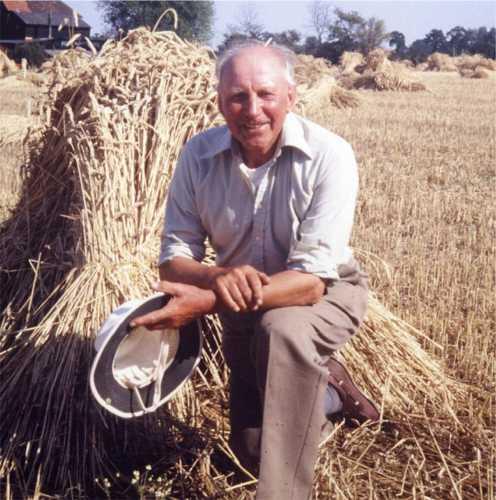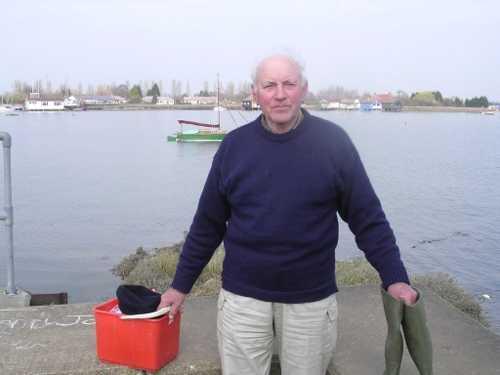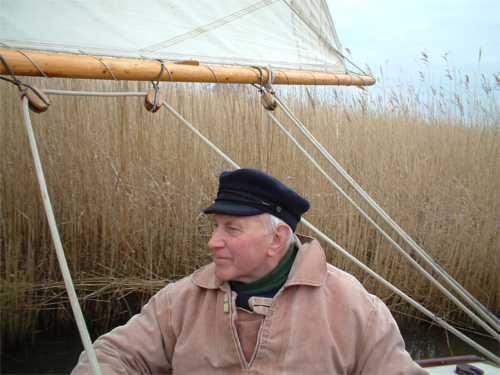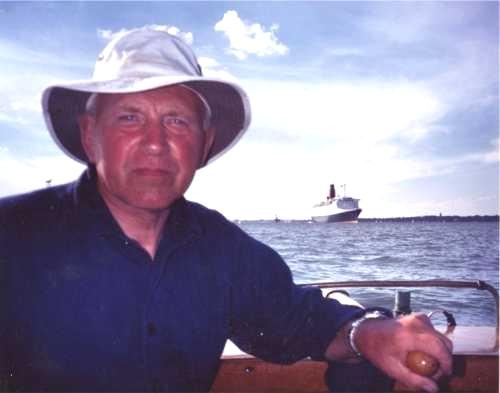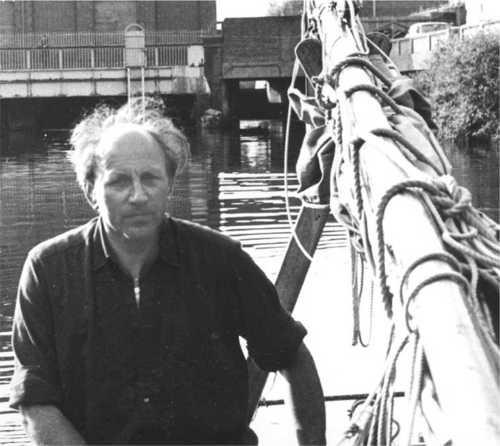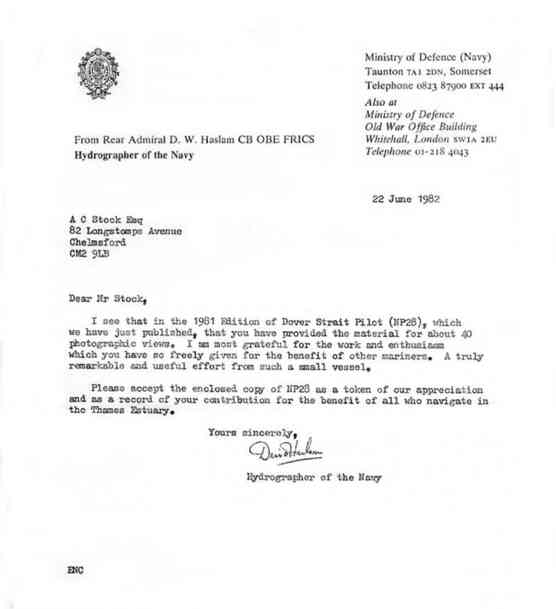Born the eldest son of a gardener in Woodford Green in 1927 to a family that had drifted into the fringe of expanding London from Finchingfield in the 1860’s; I won a scholarship to the New Buckhurst Hill High School at the age of eleven in 1938. When the school was evacuated in 1939 I was away with my mother’s parents in Surrey and returned to be evacuated to Chelmsford with Tottenham High School. For the first year I attended Chelmsford Grammar School in the mornings while Tottenham used the school in the afternoon. My first host was soon called up and I moved in with the parents of a school friend that I had made locally. Frank Little had been born in Maldon, in a house overlooking Sadds timber Yard and the flourmills, each served by Thames Barges. Gladys Little was born in the Skinners Arms pub at Manningtree, another place famous for its barges. From them I soaked up much of the world famous Essex seafaring tradition. For the first two years I had classes in carpentry and excelled but these ceased when the master was called up.
After three happy and exciting war years; gloom after Norway and Dunkirk, joy at the battle of Britain and Wavell’s thirty thousand in Africa, dismay at the loss of the Battle Cruiser Hood, some consolation with the sinking of the Bismark a few days later; one foggy Sunday morning in October 1942 I was fishing for pike in the River Chelmer when suddenly the silence was shattered by the bells of Broomfield church (silent since 1940 for use only as a warning of invasion) ringing out together with those of every other city, town, village and hamlet in the land to celebrate to news from El Alamain that the Africa Corps was in full retreat. A few days later, my father, a driver in the R.A.S.C., landed with the Second Army in Algeria.
After a reasonable school certificate in July 1943, I went home to Woodford where my mother had refused evacuation so that my father’s home would always be there if and when he returned (as he did thank, fully). I started work at the Admiralty, being allocated to Trade Division M4 where I worked on the Pacific plot. For this they had taken over the spacious adjoining bank building. The department was run by naval officers while retired merchant navy captains, all of whom has started in sail, plotted the daily positions of each ship and convoy. Teenagers moved the pins representing each ship and convoy on the massive portable charts so that an up to date version could be carried up to the War room first thing each morning. Entry of the youngsters was equal male and female but the boys were called up at eighteen years of age so that girls predominated. Having no sisters and having attended an all boys school, I found it a bit frightening, particularly when they discovered that I blushed readily. Nevertheless, I coped, they taught me my first steps in ballroom dancing and I fell in love for the first time. This was the age of glamour on the silver screen and the girls managed to look very attractive in spite of clothes rationing, much better in fact than the dreary, jean clad clones of today. They wore a lot more but this meant that there was more to unwrap!
To dodge the coalmines, I volunteered under the Y scheme as a fleet air arm pilot but was not called up until after the war had ended and switched to the Royal Marines; joining up at Deal Barracks on the 6th of January 1946. I failed to get a commission, and spent the rest of his service as deckhand on an L.C.A at the American built, landing craft base at Rosneath during the glorious summer of 1947. It was the nearest the Admiralty ever got to running a holiday camp. There were some 180 marines, about 150 wrens living in nissen huts spread among the woods on the Rosneath peninsular and some 300 matlots on landing ships moored to jetties along the shore. Days were spent training on the loch or out on the Clyde and evenings with a whist drive on Monday and Scottish dancing on Thursday at the Church of Scotland canteen, at least three films each week and dancing to the Royal Marine Band which played Glen Miller style in the dance hall. Fourteen foot sailing dinghies were available and the seventy two foot ex German windfall yacht was allocated to the base. To perfect the summer, the Victory Fleet Review was held on the Clyde at the same time as the yachting Clyde fortnight. Our L.C.A.1845 served the Nore destroyer flotilla. Just before Xmas 1947 I went to Chatham for a full demob with demob suit and two months leave.
I had read a book called ‘Corderoy’ about a first year on a farm and decided to take advantage of the opportunity through an ex service retraining scheme, Fortunately I found a berth at Chelmsford and returned to live with Frank and Gladys Little. That summer I bought an old worn out sixteen foot halfdecker called ‘Zephyr’ and had my first sail down the glorious Blackwater River, followed by a sobering rough trip home next day which cured my crew for ever but hooked me for life. Next year I set out with a tent of balloon barrage canvas to sail to the Isle of Wight but soon found I had a lot to learn and used the six weeks available to explore the Thames Estuary from the Medway to the Alde. Early in October I set out for the Norfolk Broads as I had been awarded a year at the Farm institute at Woodbaswick Hall. Another glorious playground opened up to me, which I only relinquished three years ago. During the summer I sailed round the sandy havens of North Norfolk to Kings Lynn and had a lively trip home. Over the winter of 50/51 I built a tiny broads style, lifting cabin top for ‘Zephyr’ and that summer sailed down as far as Poole and back up to the Broads.
At a school chum’s twenty first birthday party in July 1948 I met Joy Austen and danced most of the evening with her. I was in no mood for a steady relationship but met her regularly over the years. We had formed the Maldon Yacht Club; her brother became a member and brought her along to crew on his Snipe dinghy. By this time I had a regular job running a two hundred a fifty acre farm for two doctors and lived in a cottage called ‘Folks and Crows’ in the village of High Easter. We got engaged that autumn and married just before Easter 1953, six months before my mother died. Priscilla, our firstborn arrived next summer followed by James, Penelope and Christopher. By this time I was running a 465 acre farm for land agents which lasted for twelve years to 1969. Rather than change my children’s schools, I joined the Inland Revenue where I found we got a much bigger harvest with much less effort. I retired early in 1985 ready for twenty years of sailing.
By 1962 ‘Zephyr’ was getting pretty grotty although James and I covered over 300 miles in her. I remembered how Francis B. Cooke stepped the sound gear from a boat with a rotten hull into the sound hull of a boat which had lost her gear to a passing barge after anchoring for the night too far out into the channel off Queenborough. I decided that the best hull was the Falcon dinghy, hot moulded by Fairey Marine in the enclaves once used for mosquito aircraft. It was delivered home at the beginning of February 1963 for £137 /10/- during that very cold winter. The owner of the estate had offered me the use of a stout brick shed built in 1914 to house an electric charging plant for the big house until the mains arrived in 1957. She was launched the week before Whitsun and completed her first one hundred miles weekend passage round the Isle of Sheppey six weeks later. Ill health has forced Joy to give up serious cruising over the last two seasons although she still has a night out on the river in fine weather. I am still fit but the old bod is definitely giving out and the brain is not quite so sharp but this is compensated for by the fact that I have sailed the same boat for forty three years. During this time I crewed in EAORA events & several North Sea races together with six trips as watch officer on the STA Schooners.
Over and above earning a living and sailing, I have always taken a keen interest in public affairs, deluging the local press with letters and more lately phoning into the local radio talk shows. I was a member of Chelmsford R.D.C., the Central Council of the National Association of Conservative & Unionist Associations, the Council of the R.Y.A. and vice chairman of the latter’s Training Committee in its early days. I taught sailing and navigation at evening classes for over thirty years and have given colour slide lectures to yacht clubs and other bodies throughout the southern half of the country. During the days of political meetings in every parish, I was a supporting, warm up, speaker to The Rt. Hon. R.A. Butler, Sir Hubert Ashton M.P.(Chelmsford) and Brian Harrison M.P.(Maldon) having mastered a serious stammer in early life. I twice addressed 3000 people at the Conservative Annual Conference and once took the Archbishops’ chair for a debate in Central Hall Westminster.
All in all it has not been an outstanding successful life but it has seldom been dull. I cheerfully admit to being a man of limited ability in a wide field of human achievement and consider that I chose a good year in which to be born.
While left at Porchester SC between the 1977 Fleet Review and Cowes Week, a German, who had stolen a yacht from Hamburg, broke in; not realising that I was on board (no dinghy astern). He looked a tough customer so I introduced myself by slugging him with a sestrel hand bearing compass as he came into the cabin. After a short struggle, he fell overboard and I escorted him ashore to an auxiliary coast guard whom I alerted with a barge horn. He had been welcomed at yacht clubs along the south coast and lived by robbing their boats.
Another interesting event was taking photos of beacons and other features for the new Dover Pilot. An elderly Scottish skipper once described the Admiralty Pilots as the most important books in the world after the Bible and the Book of Common Prayer. The Royal Navy has been compiling them for hundreds of years. Captain Cook, Matthew Flinders, William Dampier and endless others have contributed. I was proud that join the list in however modest a fashion.


